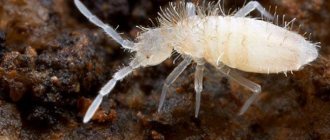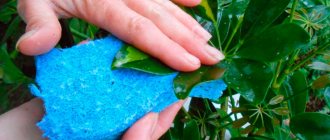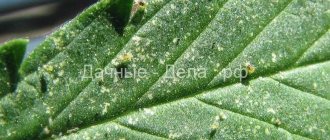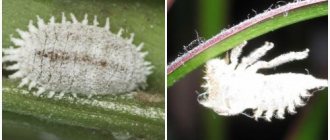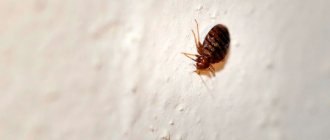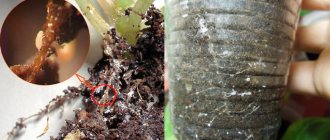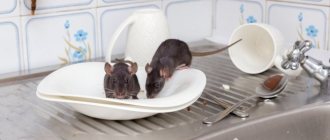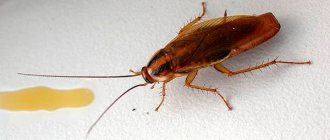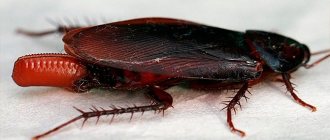Mealybugs are widespread and dangerous pests of garden and indoor plants. These insects belong to the family of arthropods, the superfamily of scale insects. The closest relatives are scale insects.
Despite their relatively large size, which allows adult scale insects to be seen with the naked eye, the onset of infection is difficult to trace. The bristly waxy fibers that cover female scale insects delay the action of plant protection products.
How to deal with the pest?
A mild mealybug infestation can be dealt with relatively quickly.
Usually it is enough to clean the plant with a cotton swab or a soft brush dipped in dissolved soap. After removing the pests and their white secretions, you need to spray with green soap, infusion or, repeating it three times with an interval of one week. A good result is also obtained from treatment with alcohol or tincture purchased at the pharmacy. Instead of repeated spraying, it is permissible to remove pests with a cotton swab or paper towel soaked in one of these preparations. Both must be destroyed immediately after the procedure is completed to avoid the spread of surviving insects.
From folk remedies
, which are easy to prepare at home, the following can be recommended for spraying:
1. Soap-alcohol mixture:
Crushed soap – 1 teaspoon; – vodka – 2 tablespoons; – water – 1 liter.
Vodka can be replaced with one teaspoon of pure alcohol. Dissolve the soap in a small amount of hot water, add up to a liter and add vodka or alcohol. Spray the entire plant with the resulting mixture, avoiding its contact with the substrate. After a day, be sure to rinse off using warm water. Repeat after three or four days.
2. Garlic solution:
Garlic – 25 grams; – water – 1 liter.
Mash the garlic and pour boiling water over it. Let it brew for six hours, then strain and apply for spraying.
3. Tincture of orange peels: pour a small amount of dry or fresh peels with hot water and leave for two to three days. Spray at intervals of several days.
Chemicals
to fight scale insects
If the mealybug infestation is severe, washing and removing the pests by hand alone is no longer sufficient. Chemical treatments will have to be used. Since the mealybug is a sucking insect, contact and combined action drugs will be the most effective to combat it.
1. Aktara
– a popular insecticide with enteric contact action. The active substance is thiamethoxam.
2. Aktellik
– organophosphorus non-systemic insectoacaricide. The active ingredient is pirimiphos-methyl. The drug is highly toxic and not suitable for use in residential areas.
3. Bankol
– contact-intestinal insecticide. Its active ingredient is bensultap.
4. Biotlin
– contact-intestinal insecticide. It is based on a rather dangerous substance – imidacloprid.
5. Vertimek
– a non-systemic insectoacaricide of biological origin. The active ingredient is abamectin.
6. Spark “Double Effect”
– a drug based on pyrethroids, which are considered not dangerous for warm-blooded animals and humans. Contains cypermethrin and permethrin. Has an intestinal contact effect.
7. Calypso
is a systemic drug belonging to the chloronicotinyl class. It has both a contact and pronounced intestinal effect.
8. Confidor-Extra
– a systemic drug based on imidacloprid.
9. Tanrek
– a broad-spectrum drug based on imidacloprid.
10. Fitoverm
– biological insectoacaricide of intestinal and contact action. The main substance is aversectin.
11. Admiral
– hormonal insecticide of contact-intestinal action. The main substance is pyriproxyfen.
Of the purely biological agents against mealybugs, you can use Lepidocide
.
Mealybug
– one of the most dangerous pests that harm indoor plants. A sucking insect that grows up to five millimeters in length. It mainly damages young shoots and leaf axils, and if the plant is massively damaged, it also damages the leaves. There are both winged and wingless specimens. The second has an oval-elongated flesh-colored body, there are bristles at the edges, and the body itself is covered with a white powdery coating. Winged specimens have only one pair of wings.
A female mealybug can lay up to two thousand eggs along the veins, in leaf axils and on the underside of the leaf blade, which are not afraid of water, because. have protection in the form of pubescence. The larvae colonize the entire plant, right down to the roots of the plant, and have the ability to move throughout their lives. All types of scale insects secrete a sticky liquid on which sooty fungus settles. The leaves of the affected plants begin to turn yellow and fall off, the shoots stop growing, the plant weakens and dies. Pests can accumulate under the bark or under the bulb scales, which makes it difficult to find the pest.
Popular preparations for indoor plants
Mealybugs, which are easier to get rid of when young individuals are just born, often colonize a plant in several families. The problem is that the generation periods of different families do not coincide in time. As soon as we get rid of some insects, others are born.
In this regard, the treatment of the plant should be repeated 2-3 times at intervals of 1-2 weeks, depending on the degree of infection. Preparations should also be alternated in order to choose the most effective one for a given type of mealybug and for a particular plant.
Table of the most popular chemicals for combating mealybugs:
| Name | Characteristic | Action |
| Akarin | Biological product of contact-intestinal action for treating garden and agricultural crops against ticks and other insects. The active substance is neurotoxins, which are produced by soil fungi - streptomyces. | The substance enters the sap of the plant on which insects feed and has a paralyzing effect. The exposure time for sucking insects, which are mealybugs, is 8-16 hours. Acts faster at high air temperatures. Does not develop habituation in pests, acts selectively. Treated plants become safe for humans after 2 days. |
| Aktara | A drug from the group of neonicotinoids, the active substance of which is thiamethoxam. Enteric contact effects on a wide group of plant pests. | Penetrates into plant tissue, onset of action is 30 minutes, retains its effect for 30 days. The process does not depend on weather conditions and air temperature. Treated plants become safe for bees, birds and other animals after 4-5 days. |
| Aktellik | A broad-spectrum insecticide that is used not only to destroy a wide range of plant pests, but also to disinfect areas, vegetable stores, and for treating seeds. The active substance is the organophosphorus compound pirimiphos - methyl. | Differs in speed of influence. Optimal temperature range: 15-28o. 1-2 treatments are enough. The substance is highly toxic, has a strong unpleasant odor, and is not allowed for treating indoor plants in residential areas. Not recommended for prophylactic use. |
| Bankol | A biological product from a Japanese manufacturer, the basis of which is an enzyme produced by a marine annelid. The resulting substance bensultal has a wide range of effects. | Causes paralysis and death of pests after 3 days. Temperature range: -10 - +30o. The drug is non-addictive, odorless, and non-toxic to animals and humans. Does not harm bees and does not accumulate in the soil. |
| Vertimek | Insectoacaricide from a Swiss manufacturer, the active ingredient of which is abamectin. | The penetrating effect occurs after 2 hours and lasts for a month. Fruits and vegetables can be consumed one week after treatment. It is not washed off by rain and works at any temperature. |
| Inta-vir | A broad-spectrum peritroid that affects more than 50 species of insects. The main substance is cypermethrin, which is synthesized from Dalman chamomile flowers. | The death of insects occurs after 2-3 days. Suitable for treating greenhouse and open ground plants. If simple safety precautions are followed, it is not harmful to people and animals, but 4-5 days after spraying it poses a danger to bees and fish. Not suitable as a prophylactic agent. |
| Karbofos | Insectoacaricide with a volumetric field of action. It is used to destroy insect pests in residential premises, gardens and gardens. Also used for disinfection of storage facilities. The active ingredient is malathion. | Destroys adults and larvae, bypassing the impact of egg laying. For this reason, re-processing is necessary. It acts on parasites within a few hours and quickly disintegrates in soil and water. Non-toxic to humans, very dangerous to bees. |
| Confidor extra | An insecticide from a German company for the destruction of gnawing and sucking harmful insects. The active substance is imidacloprid. | The effect on pests occurs within 2-3 hours and does not cause addiction in insects. Valid for up to a month, in the absence of heavy rainfall. It is toxic to beneficial insects. |
| Tanrek | The drug has enteric contact action and is highly effective for treating indoor plants and flowers against pests. Imidacloprid, which is the main active component, affects adults and larvae. | The drug is resistant to precipitation and toxic to bees and birds. The toxic effect lasts 12 hours. |
| Fitoverm | A domestic biological product created on the basis of aversectin C, a product produced by one of the types of soil fungus. | The effect appears after 8 hours in room conditions, after 16 – in the air. The final effect is achieved after a week. The drug is non-toxic and environmentally safe, but it is not advisable to get into water bodies. Requires several treatments. |
Before using any chemicals, you should carefully read the instructions and take the necessary protective measures. It is not recommended to exceed the dosage; it is better to repeat the treatment if necessary.
Why do they grow on indoor plants?
A favorable environment for the appearance of a pest is:
- excessively dry air;
- application of contaminated soil
; - excess nitrogen fertilizers;
- lack of hygiene procedures.
The infected specimen begins to wither and lose leaves, it takes on a depressed appearance. Upon careful examination, you can find small white fluffy lumps on the leaves.
How to deal with a pest
Before fighting harmful insects, the infected flower should be isolated from the rest.
. Scale insects can also move to neighboring flowers, so they should be inspected regularly.
The affected areas are treated with a soap solution in which a cotton swab is moistened. All affected areas should be thoroughly wiped. If the sheet is severely damaged, it is better to remove it. Treatment with alcohol is also harmful to the insect.
Mealybugs love dry, hot microclimates. Having created such conditions, they can be lured out of hard-to-reach places and removed. Males do not feed on the flower, but contribute to the reproduction of pests, so they also need to be fought.
Males are harder to spot
, because they are found in the soil near the flower. Traps are set up for them in the form of sticky tape, which is fixed near the light source.
After the leaves and stems have been thoroughly washed, they are treated with insecticides.
To do this, poisons are used in different forms:
- spray;
- sprayers;
- granules;
- sticks;
- oils
Sprays are sprayed from a certain distance so as not to harm the pet
The granules are placed in the soil, being careful to protect the roots
Oils are applied to damaged areas. Healthy leaves do not need to be lubricated; this may disrupt the metabolic process.
Spraying is carried out with the following preparations:
- Aktara;
- Calypso;
- Confidor;
- Tanrek;
- Fitoverm.
We described in detail the procedure for using the latter in the article.
There are other effective drugs
to treat affected pets.
Before you start using this or that product, you should read the instructions to avoid harm to the plant.
As an additional means, you can choose one of the traditional methods of pest control:
- treat
the affected areas
with infusion of fragrant tobacco
; - wipe with calendula tincture (can be purchased at a pharmacy);
- treat with garlic infusion (cut 5 cloves and pour liters of boiling water over the floor, leave to infuse for 4 hours).
You can use microbiological preparations, in particular lepidocide
.
Fighting mealybugs on indoor plants with folk remedies. Recipes and application diagrams
The mealybug, which many chemicals help get rid of, is a very tenacious creature by nature. Traditional methods and remedies also prove effective, but only in the initial stages of infection.
Running water
Cleaning under a strong stream of warm running water will help wash away the pests from the plant. Before processing, remove the flower from the pot and thoroughly wash all parts, including the roots. After drying, the plant is transplanted into new soil. The method is not suitable for those specimens for which water procedures are contraindicated , for example, for violets.
Soap and alcohol
For a soap-alcohol solution, combine water (1 l), liquid soap (1 g) and purified alcohol (10 ml). Wash the plant with this solution using a cotton swab.
Garlic solution
Garlic tincture is used to spray the affected plant.
To do this, chop the cloves of a medium head of garlic and pour in 0.5 liters of boiling water. The infusion is ready for use after 5 hours.
Calendula
The medicinal disinfectant plant calendula can also help in the fight against pests. The infusion is prepared from 100 g of dry material and 1 liter of water. After a day, the tincture is used to wash the affected areas.
Signs you have a mealybug
reverse side
Since the mealybug sucks nutrients from the leaves, the leaves may be deformed, and the plant itself is greatly inhibited in growth.
It is necessary to look for mealybugs not only on the leaves, but also in the root system. As it turns out, it does well in pots too. That’s why I’ve recently fallen in love with transparent pots, because you’re less likely to miss some “uninvited guest.”
First, I cleaned all the leaves of plaque and insects using a cotton pad soaked in a solution of green soap. The soap remaining on the foliage and stems will help the active drug linger on the green part of the plant, rather than safely forming a droplet and draining from the leaf. Since I did not have time to wait for further manifestations of the mealybug, the next day I treated it with Fitoverm. There are a lot of drugs that are recommended for mealybugs, but I have been using Fitoverm for a long time, since it gives positive results for me.
I make a fairly strong solution: 2 ml of the drug per 200 ml of water for spraying and watering. First, I thoroughly irrigate the plants, and then pour them at the root. If possible, it is better to change the soil of the infected plant, since I had a recently purchased plant and I was going to change the soil and pot anyway, so I immediately did this. I bake the soil for all my plants in the oven so that when I change the soil, I don’t get any other pests. I even carefully cultivate the store soil.
I washed the roots with Fitoverm and thoroughly sprayed the green part of the plant. The treated plant can be left in quarantine for a week, and after a break the treatment can be repeated.
The waxy coating makes mealybugs very difficult to kill. Therefore, the poison will only affect young individuals. Adults will have to be removed manually. Because of this feature, the treatment can be repeated two to five times!
Which mealybug treatments are best for certain plants?
Mealybug infestation of indoor plants occurs in different ways, depending on the characteristics of the flower. For this reason, methods of getting rid of the pest may also be different. For treatment, it is recommended to take house plants out into the fresh air, especially if the drug is highly toxic.
For orchids
On orchids, mealybugs affect not only the leaves, but also the aerial roots.
The best products for these flowers are:
- biological products: Fitoverm and Vertimex;
- toxic agents: Calypso and Aktara;
- Actellik – for heavily affected plants.
Preparations for mealybugs on orchids
In the initial stages of infection, the orchid will be helped by frequent washing or treatment with folk remedies.
For violets
Mealybugs, which are very difficult to get rid of on violets, spend their life cycle at the roots of the flower. The damage becomes visible at the stage when the plant is already in serious danger. In such cases, you should not waste time on treating with gentle means; you should immediately use a serious, effective drug, for example, Actellik.
For ficus
Of all the types of ficus, the mealybug prefers Ficus Benjamina the most. On this plant, small white individuals cover entire colonies of leaves and stems.
You can get rid of mealybugs on ficus by wiping the leaves of the plant.
To destroy the pest, use:
- washing;
- folk remedies;
- processing by any of the means described above.
For cacti
On cacti, these pests settle either at the top, on fresh growth, or at the base of the stem. In the second case, it is initially difficult to detect them.
A small apical infection can be destroyed by washing with water, or treated with a strong infusion of garlic. Among the chemical protection products for cacti, insecticides whose active ingredient is imidaloprid have proven themselves to be the best.
For cacti you can use:
- Karbofos;
- Aktellik;
- Sherpa;
- Decis.
For dracaena
The appearance of the pest on dracaenas is facilitated by excessive humidity at high air temperatures. The initial infection can be washed off with soap and water. If the insects have spread over large areas, only insecticides will help.
Effective in these cases will be:
- Aktara;
- Fitoverm;
- Confidor.
After the pest control procedure, you should definitely change the soil for the plant and disinfect the pot.
Insecticides to help the gardener
In search of how to get rid of a parasitic insect, they resort to the help of “chemistry”. Before using this or that substance, you need to reliably make sure that the pest is really a mealybug. A photo of this particular insect will help identify the parasite.
Pest control, especially at an advanced stage of plant damage, will be most successful with the use of combined-action chemicals that kill not only adult insects, but also egg laying and larvae. These are so-called insecticides (systemic). The drugs are able to penetrate inside the plant. Moving along the canal system, they reach its top and roots. Therefore, wherever the mealybug is, it will begin to feed on the poisoned juice and then die.
Mealybugs in the roots can only be destroyed with chemicals
White, fluffy, shaggy, wet new growths on ficus benjamina are sprayed with Mosplan. You can use Actelik, characterized by enteric contact action. Each instant mixture must be prepared following the instructions included in the instructions. On dracaena, continue treatment at intervals of 4 days until the scale insect is completely destroyed.
To treat decorative floral greens, you can alternately use Fazalon and Fitoverm for mealybugs. The latest preparation of the biological series of IV generation insecticides. They can cure diseases of orchids caused not only by scale insects, but also by aphids, as well as other harmful organisms.
A number of chemical reagents are supplemented by Mospilan, Konfidor-maxi, Ponche. They are diluted simply: 1 g of substance per 1000 ml of water. The plants are not watered too much with these solutions. To prevent the pest from getting used to one poison, watering is repeated after 7 days, but with Spirotetramat or Aplaud (from a series of new drugs). The time of exposure of the mealybug to different chemicals differs. But, ultimately, the dried bodies of killed insects are always found on the ground in a flower pot.
Fighting with chemicals
When the early stage is missed, and the invasion of harmful insects already threatens with disastrous consequences, then you have to fight using chemicals.
Affected indoor flowers and fruit and berry bushes need to be treated more than once at intervals of several days. The drugs that pests fear work in three directions:
- Systemic ones poison the juice without causing harm to the plant itself (Phosfamide, Rogor, Mospilan).
- Intestinal ones cause poisoning and digestive disorders (Aktellik, Akarin, Fitoverm, Nurell-D, Aktara).
- Contact ones act on the skin. Such drugs are used once (Spruzit-AESchadlingsfrei).
Let us pay special attention to the most effective chemical means of control. Aktara is a well-known complex drug
The solution must be thoroughly sprayed onto the plant and watered the soil to provide it with access to the root system. Aktara begins to fight hairy insects within half an hour and retains its effect for about a month. Suitable mainly for fruit plants. This product is very effective, but with frequent use it loses its properties, as pests become addicted. Aktara acts on the digestive system and reduces appetite
Aktara is a well-known complex drug. The solution must be thoroughly sprayed onto the plant and watered the soil to provide it with access to the root system. Aktara begins to fight hairy insects within half an hour and retains its effect for about a month. Suitable mainly for fruit plants. This product is very effective, but with frequent use it loses its properties, as pests become addicted. Aktara acts on the digestive system and reduces appetite.
It also has a poisonous effect. It does not harm the root system, since it consists of waste products of soil microorganisms and is completely dissolved in the soil. After just a few hours, the pests lose activity and soon die. Treatment with Fitoverm can be repeated after two weeks.
Aktara, Fitoverm, as well as Komandor and Zolotaya Iskra are considered the most aggressive and effective chemicals. With their help, you can fight even large colonies of mealybugs and those varieties that settle in the root system.
Types of mealybug
There are more than two thousand species of scale insects in the world, most of which live in the tropics. In European countries there are only a little more than three hundred of them. And in the territory of the former Soviet Union there are even fewer: bristly, grape, seaside, citrus and Comstock scale insects.
Bristlebug
(
Pseudococcus longispinus
) reaches a size of 3.5 mm. This is the length of an adult female; males are much smaller. The body shape of this species of insect is elongated-oval, the color can be orange or pinkish with an obligatory white coating. Both females and males are very mobile - the insect's legs are well developed and allow it to quickly move from one plant to another. Only females feed. Males are much less common and do not cause much harm. Female bristlebug females do not lay eggs - they are viviparous.
Bristlebushes live on the undersides of leaves, in the axils and on the tops of tender young shoots. They can settle on bulbs. Affected leaves and shoots turn yellow and lag behind in development. The scales of bulbous plants dry out and pests get under them.
Unlike the bristly bug, the grape bug
(
Pseudococcus citri
) oviparous. Females have a broad oval body, yellow or pink, covered with a powdery coating characteristic of this type of insect. The larvae that hatch from the eggs immediately spread to nearby plants, settling along the leaf veins and on young shoots. With severe damage, they can form huge colonies that quickly suck out the cellular juices of their host, which leads to wilting and death of the plant.
Primorsky mealybug
(
Pseudococcus affinis
) is considered one of the most common.
Adult females reach a length of 4 mm with a body width of up to 2.5 mm. The color is grayish-pink with a white waxy coating. The males of this insect are much smaller and have wings that allow them to move through the air throughout the summer. The eggs of the female seaweed are laid in white egg sacs consisting of fluffy cobweb secretions. If desired, it is not difficult to find them in various secluded places: inside curled leaves, in cracked bark, on the branches of branches. The larvae of the mealybug are small and mobile, yellowish in color and completely without a white coating. They are transferred very quickly: on animal fur, human hands and clothing, and simply by the wind. Like the adult insects that these babies will turn into in a month, they suck out the juices of plants, causing their oppression and death.
Comstock's worm
(
Pseudococcus comstocki
) is a fairly large insect, up to 0.5 cm long. Its homeland is East Asia, from where it was introduced to other countries. During the Soviet Union, this dangerous pest was considered a quarantine object, both internal and external. Limited outbreaks of it are still often found in Kyrgyzstan and Tajikistan, certain regions of Transcaucasia and southern Kazakhstan. In warm climates, it reproduces very quickly - it is capable of producing three generations per year. Usually overwinters in the ground. It lays eggs in cracks in the bark and in the soil, where it spends the winter. One clutch can contain up to 600 eggs. The larvae appear in April and immediately begin to feed on the leaves and shoots of plants. Sometimes even tree trunks, perennial tubers and roots are affected. They quickly spread along with the fruits and are carried by water and wind contaminated with planting material.
Mealybug pest. Description and signs of plant infection
Mealybugs, which are sometimes difficult to get rid of, can cause serious damage to garden crops. Through oral suckers they attach themselves to the entire area of the plant and drink their juices. The appearance of insects of different sexes is not the same. Females are white bugs with a waxy coating, ranging in size from 3 to 5 mm. The body shape is oval, with many legs and antennae on the sides.
The larvae have the same appearance, only the sizes differ. It is the females and larvae that harm plants. Male scale insects in most varieties look like small white moths that flutter over the plant.
They cannot drink juice because they do not have a mouth opening. The most mobile are the mealybug larvae, which constantly move, infecting new areas of the plant.
The reproductive capacity of this insect species is very high. The female is capable of laying up to 500 eggs at a time and hatching 2-4 generations in a year. The list of crops that can be affected by the pest is very extensive, but most often the mealybug attacks fruit and rose bushes. Popular types of house flowers also suffer from the insect.
The appearance of scale insects on plants can be determined by the following signs:
- Presence of small white insects.
- Leaves, buds, and stems are covered with a powdery coating.
- “Honeydew” appears - sticky mucus.
- In some places, sooty fungus begins to develop.
- The general condition of the plant deteriorates, active vegetation stops.
Mealybug: signs of plant damage by a pest
More than 1,500 species of mealybugs are known in the world, most of which live in tropical forests. Only a few of them are common in temperate climates.
Bristle mealybug (Pseudococcus longispinus)
This species of mealybug differs from the others, first of all, in the way it produces offspring. The female bristlebug does not lay eggs, but gives birth to ready-made larvae of the 1st stage in the amount of 200-300 individuals. The life cycle is approximately 6 weeks in summer, 12 weeks in winter. Females and males, who are very similar in appearance, feed on the sap of the plant.
These insects are very mobile, quickly move throughout all parts of the plant, and can infect roots. Externally, bristly mealybugs are distinguished by the presence of long tail filaments, which sometimes exceed the length of the body. Most often, colonies of the bristlebug settle on the lower part of the leaves or on the tops of young shoots.
Bristle mealybug (Pseudococcus longispinus)
They can get under the scales of bulbs or under the bark of citrus plants. The range of plants that become home to colonies of this scale insect species includes a large number of ornamental and horticultural crops.
Grape mealybug (Pseudococcus cifri)
This type of insect leads a sedentary lifestyle. Harm to crops is caused by females and larvae that emerge from eggs laid in a bag of wax threads. Larvae are more active than adults and move quickly in search of a fresh place.
There are few male butterflies; they hover over the plant without harming it. The grape mealybug produces less waxy coating, so its yellow-pink body is visible. This insect causes enormous harm to plants in greenhouses and conservatories.
Grape mealybug (Pseudococcus cifri)
Often affects indoor plants:
- ficus;
- palm trees;
- crotons;
- Kalanchoe;
- cheflers.
In the garden you can find it on cucumbers and eggplants, in the flower garden - on roses and gerberas.
Seaside mealybug (Pseudococcus affinis)
This variety of scale insect is the most common and most resistant to biological plant protection agents. Externally, the seaside mealybug is similar to its grape counterpart, but a thick layer of wax makes it snow-white.
Females construct bags for laying eggs, and the larvae quickly spread throughout the plant. They cause the greatest harm to ornamental crops and indoor plants; they can settle on tomato stems.
Types of Mealybugs
Bristle Mealybug
Bristle mealybug (Pseudococcus longispinus) - females and larvae harm plants. The body of an adult female is 3.5 mm long, oval in shape, orange or pinkish in color, covered with a white coating. The scale insects have well-developed legs, thanks to which they can easily move from plant to plant. Females are viviparous. They usually accumulate in the form of colonies on the underside of leaves, on branches, in leaf axils and on young shoot tips.
The bristlebug is a fairly large insect, easily noticeable on the plant due to the white powdery coating that covers its body and the white waxy formations in the form of cotton balls. Damaged leaves turn yellow and fall off. Shoots are stunted in growth. Scale insects crawl under the bark of citrus fruits and under the scales of bulbs of bulbous plants. Plants damaged by scale insects are severely depressed, stunted in growth, leaves turn yellow and fall off. Sooty fungi can settle on the secretions of scale insects.
Grape mealybug
Grape mealybug (Pseudococcus citri) - the body of the female is broadly oval in shape, pink or yellowish in color, covered with a white powdery coating. Legs are well developed. Males are very rare. The hatched larvae settle throughout the plant, on shoots, on leaves along the main veins. When severely damaged, scale insects form huge colonies that suck all the juices out of the plant. The leaves turn yellow, the shoots dry out. Sooty fungi settle on the secretions of scale insects.
Bristle mealybug (Pseudococcus longispinus). Snehasis SinhaVine mealybug (Pseudococcus citri). Jeffrey W. Seaside mealybug (Pseudococcus affinis). energvmeno
Primorye mealybug
The seaside mealybug (Pseudococcus affinis) is one of the most common species of mealybug. The body of an adult female is elongated-oval, 3-4 mm long, 2-2.5 mm wide, grayish-pink in color, covered with a white powdery coating. Legs are well developed.
Males are much smaller, winged, and fly all summer. Females lay eggs in egg sacs, which are a white, fluffy, shapeless mass of waxy cobweb secretions. Typically, oviparous females hide in secluded places: cracks in the bark, in twisted leaves, in the forks of branches. The larvae are small, mobile, yellow, completely devoid of waxy coating.
They quickly spread throughout the plant and are spread by wind, humans and animals to other plants. The larvae turn into an adult insect in 1-1.5 months. By sucking out all the juices from the plant, they cause stunting and then death of the plant. Damaged plants grow poorly and do not bloom. Sooty fungi settle on the secretions of scale insects. The leaves turn yellow and fall off.
We hope that our tips for dealing with scale insects will help you! We are waiting for your comments!
How to get rid of a pest?
Let's consider several means:
Chemical
During the period when new individuals are just born, chemical agents provide the necessary effect of the highest quality type. This period is the moment when the scale insects are just emerging from the mother’s womb or hatching from the egg. At that time, insects had not yet acquired a special protective wax, and their body was quite vulnerable during this period.
The use of chemicals means that in order to achieve the desired result, the effect must be applied regularly for two weeks. But the main difficulty in eliminating these insects on a plant is that only young individuals can be eliminated with the help of chemicals, while adults will continue to develop and create their own kind.
You need to understand that the longer you delay the process of fighting the larvae, the more difficult and unrealistic it will be for you to remove them.
Attention! Sprayers are best suited for killing these insects. Once on the leaves of a particular plant, this medicine is absorbed
At the same time, insects suck out the juices of the plant with poison for them.
How to deal with mealybugs and what is suitable for cultivating the soil of indoor plants? Widely available effective drugs against mealybug are:
- Decis.
- Tsvetofos.
- Vertimek.
- Nurell D.
- Bi-58.
- Phosphamide.
- Actellik.
- Fitoverm.
- Upload.
Folk
Traditional medicine offers a number of ways to eliminate scale insects from plants:
- Horsetail tincture. Using it, you need to spray the leaves and add medicine to the root. This product can be purchased at any pharmacy.
- Spraying with a certain oily substance. The recipe for such a substance is as follows: for one liter of water you need two tablespoons of olive oil. Next, this content is applied to the leaves of the plant.
- A solution containing alcohol and soap. This solution contains 15 grams of soap and 10 milliliters of alcohol. All this must be added to warm water.
- Garlic based tincture.
How to get rid of it: folk remedies
In the early stages, getting rid of scale insects is quite easy. You need to thoroughly clean the plant with a cotton pad, stick or soft brush. Alcohol and alcohol tinctures or soapy water will do. Next we will tell you what to do in each specific case!
Mealybug on orchids
Orchids are very delicate, so they require gentle and gentle methods. Remove the affected flowerpot away from the rest and thoroughly wipe the entire above-ground part of the plant with a mild soap solution. Use a soft sponge and brush in hard-to-reach places. Then spray the orchid with tobacco infusion (80 g per liter of water) three times at intervals of a week.
Photo: pot-flowers.ru
Mealybug on cacti
On cacti, scale insects most often settle at the roots or on the young crown. The same goes for succulents. Sure symptoms of parasites are slow growth, causeless death of young leaves and brown stains at the sites of bites.
In the case of unpretentious cacti, hot water of about 45-50 degrees is sufficient. You need to carefully rinse the plant under running water along with the roots and clean off all parasites with a brush. If there are very few pests, first try treating the areas where they are located with a garlic solution. Mash 25 g of garlic, pour a liter of boiling water and leave overnight.
Photo: nashgazon.com
Mealybug on violets
It can be problematic to notice mealybugs on violets, because here they also hide at the roots. If the damage is minor, you can try orange infusion: pour boiling water over the dry peels and leave for several days. Repeat spraying 3-4 times with an interval of 2-3 days.
In more advanced cases, we recommend not experimenting with traditional methods and immediately using one of the professional medications. If this does not help, you will have to remove the violet from the pot, thoroughly clean the roots and process the entire lower part. And then transplant into a fresh, disinfected substrate.
Photo: grizun-off.ru
Mealybug on ficus
First, remove all visible pests with a cotton pad or swab in a mild soap solution. It is better to remove the most damaged parts of the plant altogether. To detect mealybugs that have managed to hide, leave the flowerpot in a warm, damp place - and they will soon crawl to the surface.
A special green potassium soap is suitable for treating ficus. About 15 g of shavings are needed per liter of water, and the treatment is repeated three times. If there are not too many scale insects, wipe the damaged areas with a cotton pad in calendula infusion.
Photo: indoor.aleshamusic.com
Mealybug on dracaena
If there are only a few individuals, remove them from the leaves and treat them with a weak alcohol solution. To remove it again, it is convenient to use a cotton swab or toothpick. In addition, calendula tincture is also suitable here, which is enough to wipe the damaged areas.
On dracaena, spraying with an alcohol-soap solution works well - 10 ml of liquid soap and 10 ml of alcohol per liter of water. By the way, if you have an alcohol-containing skin lotion, you can try it. Finally, the leaves are treated with olive oil - 2 tablespoons per liter of water.
Photo: forum.bestflowers.ru
The most useful indoor plants: names and photos (catalog)
How to recognize
Mealybug infestation of indoor plants is determined by the following signs:
- On the surface of the leaves you can see an incomprehensible nectar in the form of drops.
- On the stems, buds and leaves, as well as in the root zone, colonies of this pest are visible, similar to cotton wool with white cobwebs. There can be many such colonies. The more affected areas, the more difficult it is to cope with this pest.
- The stem begins to deform, and the growth of the flower is inhibited. At the same time, its appearance deteriorates.
- The leaves curl, turn yellow and begin to fall off as they lack nutrients.
- The action of the mealybug promotes root rot.
- If you do not fight this parasite in time, there is a risk of plant death.
- The life activity of the mealybug is distinguished by one feature: if there are no favorable conditions, then this parasite can remain in an inert state for a long time, that is, in a state of suspended animation. When the temperature and humidity reach the optimal level, the mealybug immediately begins active life, sucking the juices from the plant and continuing to reproduce.
Description of the pest
Externally, mealybugs are very similar to ordinary aphids. The size of the insect is sufficient to be detected by the naked eye. The body length of adult individuals ranges from 3 to 7 mm. These creatures seem to be sprinkled with flour on top - a special substance that protects them from drying out, because mealybugs do not have a hard chitinous apparatus.
It is noteworthy that females and males of these insects differ significantly in external characteristics. Females have an oval body that is covered with powdered wax. Females have many short legs and long antennae. Young mealybug larvae are very similar to females, but are much smaller in size.
Males are winged insects, similar to mosquitoes or small annoying midges. They do not have mouthparts, so they do not feed on the leaves of flowers and harm them.
It is not difficult to recognize the presence of a pest on plants, since the result of its vigorous activity on indoor flowers is the appearance of a specific cotton-like coating on the leaves. It is in this “fluffy mass” that female mealybugs lay their eggs. A female dna is capable of creating a clutch of 500-600 eggs. Such fertility of the insect ensures its rapid spread to neighboring plants.
The mealybug is a pest that sucks the sap of indoor plants, causing a slowdown and then a complete cessation of the growth and development of the flower. During its vigorous life activity, this parasite secretes honeydew or honeydew. It is a very sticky and sweet liquid and is an excellent environment for the emergence and further development of various fungal diseases, including sooty fungus.
Usually it is not difficult to detect scale insects on plants - they are located in the axils of leaves, on stems and petioles.
